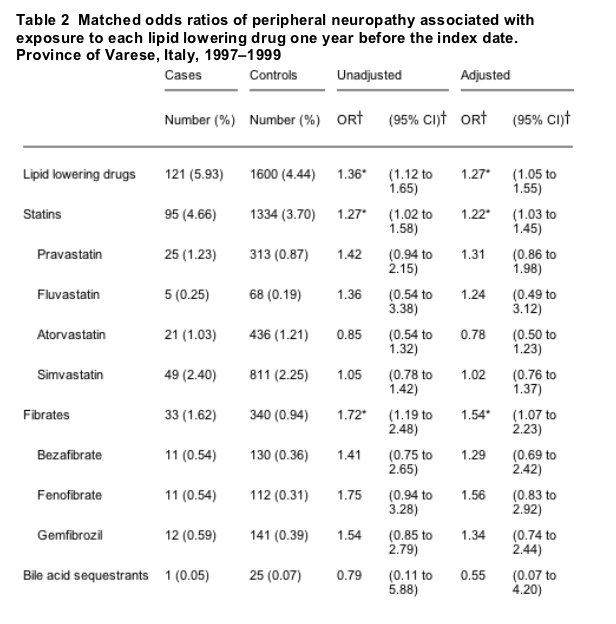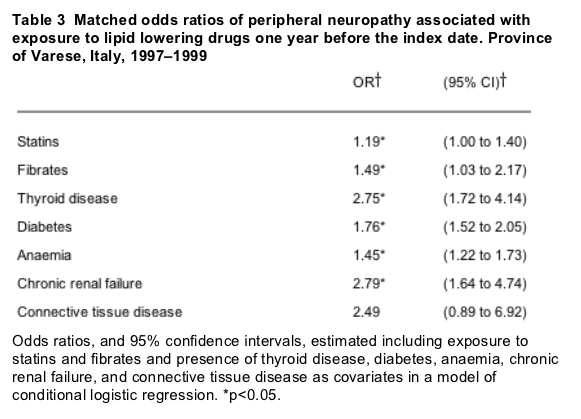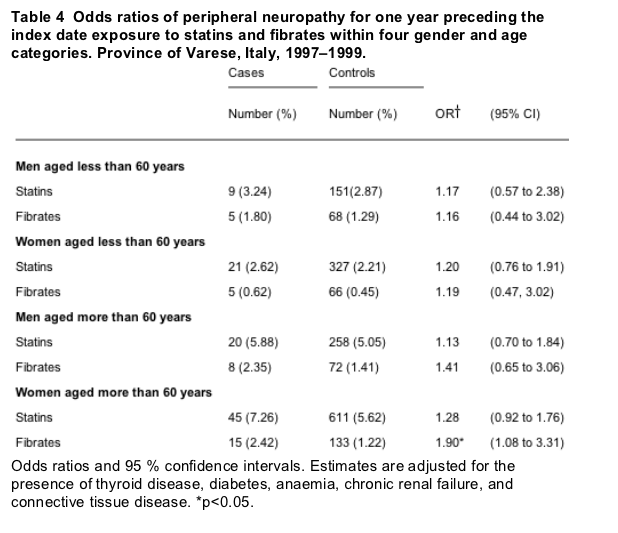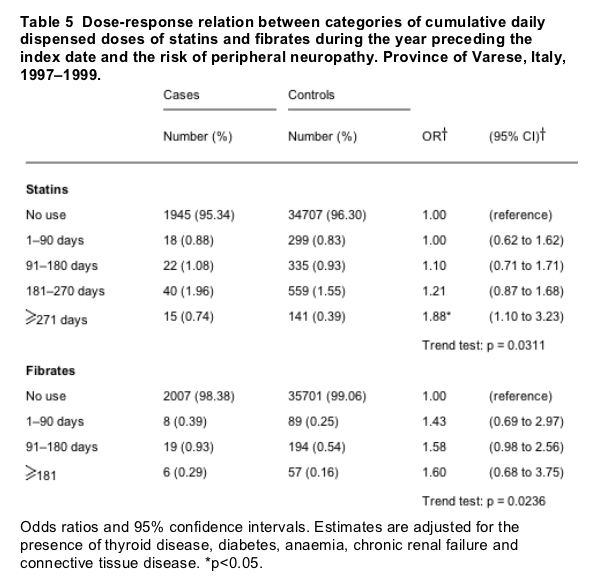| |
Lipid lowering drugs prescription and the risk of peripheral neuropathy: an exploratory case-control study using automated databases
|
| |
| |
Journal of Epidemiology and Community Health 2004;58:1047-1051
Giovanni Corrao1, Antonella Zambon1, Lorenza Bertu1, Edoardo Botteri1, Olivia Leoni2 and Paolo Contiero3
1 Department of Statistics, University of Milan-Bicocca, Milan, Italy
2 Local Health Department of the Province of Varese, Lombardia Region, Italy
3 Cancer Registry of the Province of Varese, Lombardia Region, Italy
ABSTRACT
Study objective: Although lipid lowering drugs are effective in preventing morbidity and mortality from cardiovascular events, the extent of their adverse effects is not clear. This study explored the association between prescription of lipid lowering drugs and the risk of peripheral neuropathy.
Design: A population based case-control study was carried out by linkage of several automated databases.
Setting: Resident population of a northern Italian Province aged 40 years or more.
Participants: Cases were patients discharged for peripheral neuropathy in 1998-1999. For each case up to 20 controls were randomly selected among those eligible. Altogether 2040 case patients and 36 041 controls were included in the study.
Exposure ascertainment: Prescription drug database was used to assess exposure to lipid lowering drugs at any time in the one year period preceding the index date.
Analysis: Conditional logistic regression model for matched data was used to estimate the risk of peripheral neuropathy associated with exposure to statins, fibrates, and other lipid lowering drugs.
Main results: Weak but significant effects of lipid lowering drugs as a whole (matched odds ratio: 1.27; 95% confidence intervals: 1.05 to 1.55), statins (1.19; 1.00 to 1.40), and fibrates (1.49; 1.03 to 2.17) were observed. Significant linear trends towards increased risk at increased exposure to both statins and fibrates were observed.
Conclusions: The use of both statins and fibrates was associated with the risk of peripheral neuropathy. The primary purpose of this exploratory study is signal generation. This requires further investigations to evaluate the causal role of lipid lowering drugs on the onset of peripheral neuropathy.
Pre-market trials of new drugs have well recognised limits both in sample's size and in patients' selection.1 Some adverse drug effects may therefore became apparent only after the introduction in the market, as the general use expands both the number and the diversity of patients receiving the drug.2 Post-market non-experimental studies on drugs' risk assessment have commonly used computerised administrative health databases, in a context where urgent concerns are related to drug safety and adverse conditions under study are rare.3
The preventive effect of cholesterol lowering treatment with statins on the risk of coronary heart disease, stroke, and total mortality is well reported.4,5 However, the recent withdrawal of cerivastatin from the world's market after deaths from rhabdomyolysis has focused the attention on the risk of adverse events associated with statins. Several reports suggest that statins may cause peripheral neuropathy.6,7,8,9,10,11 However, either study designs are inadequate (case reports or case series) or sample sizes of formally well designed epidemiological studies are small, so that evidences on this topic are still inconclusive.10,11 Moreover, the toxic effect of other lipid lowering drugs on peripheral nerves has never been adequately investigated.12-15
The objective of this study was to explore a possible association between the use of lipid lowering drugs and the occurrence of peripheral neuropathy.
METHODS
Target population and data sources
The study focused on all the residents in the Province of Varese, an Italian industrialised area located in the Lombardia Region, between Milan and the Italian-Swiss border, with a resident population aged more than 40 years of 820 575 inhabitants according to the 2001 Italian population census (target population). This population has been covered since 1997 by an automated system of databases on the use of healthy services including: (a) archive of residents who receive health assistance from the National Health System (practically all the resident population), reporting demographic and administrative data; (b) hospital discharge database reporting the hospitalisations that occurred in the public and private hospitals of the Lombardia Region; (c) mortality database reporting death certificates of residents in the area, and (d) prescription drug database reporting information about the prescriptions of drugs reimbursable from the National Health System.
The privacy of patient records is ensured as no recognition key is present. However, a unique individual identification code (regional healthy code) is consistently reported for all the databases to permit linkage among them.
Cases and controls selection
Hospital discharge and mortality databases were used to identify case patients. Residents in the Province of Varese, aged 40 years or more, hospitalised or dead in the years 1998-1999 and for whom the diagnosis of peripheral neuropathy (codes 350 to 359 according to the International Classification of Diseases, 9th revision) was the principal reason for admission or death, were identified from both sources. The date of the first episode of peripheral neuropathy was referred as the index date.
Up to 20 controls for each case patient were randomly selected from the archive of residents in the Province of Varese after matching for index date, gender, age (± 5 years), and the general practitioner.
Eligible patients reporting peripheral neuropathy as "secondary diagnosis" or as "other relevant condition" in presence of another primary diagnosis in the period ranging from 1997 to 1999 and those hospitalised for peripheral neuropathy during 1997 (if cases), or in the years 1997, 1998, and 1999 (if controls), were excluded.
Exposure to lipid lowering drugs
Prescription drug database was used to identify cases and controls to whom lipid lowering drugs were prescribed at any time in the one year period preceding the index date. All drugs were coded according to the anatomical rherapeutic chemical (ATC) classification of the World Health Organisation.16 To screen for specific associations, the entire class of lipid lowering drugs (ATC code: C10), statins (C10AA), fibrates (C10AB), and bile acid binding resins (C10AC) as a whole, and five statins (simvastatin, pravastatin, fluvastatin, atorvastatin, and cerivastatin) and three fibrates (bezafibrate, gemfibrozil, and fenofibrate) reimbursable from the National Health System in the considered years were investigated. Defined daily dose (DDD) unit, established as the typical adult's daily maintenance dose,16 was recorded for each prescribed drug (15 mg simvastatin, 20 mg pravastatin, 40 mg fluvastatin, 10 mg atorvastatin, 0.2 mg cerivastatin, 600 mg bezafibrate, 1200 mg gemfibrozil, and 200 mg fenofibrate). In this way, the number of DDD units cumulatively prescribed during the year preceding the index date for each included subject was computed.
Ascertainment of concomitant conditions
Hospital discharges for thyroid disease (ICD-9: 240-246), diabetes (250), anaemia (280-285), chronic renal failure (585) and connective tissue diseases (710) and anti-diabetic (ATC code: A10) and anti-anaemic (B03) drugs dispensed to each case and control during the period of observation were recorded.
Exploring reliability of diagnosis of peripheral neuropathy
A sample of 70 cases affected by peripheral neuropathy was randomly selected among those included in the study. The corresponding medical records were traced at the hospital where they were admitted at the index date and reviewed by a trainee in neurology blinded with respect to the diagnosis reported from the hospital discharge database. The findings of both clinical and instrumental tests supporting the diagnosis of peripheral neuropathy, as well as the date of the first peripheral neuropathy diagnosis, were retrieved from medical records.
Statistical analysis
The risk of peripheral neuropathy associated with lipid lowering drugs was estimated by fitting logistic regression models,17 and expressed as odds ratios (OR) and corresponding 95% confidence intervals (CI). Models first evaluated the separate effects of each lipid lowering drug without and with adjustment for the presence of all the above reported concomitant conditions. Subsequently, with the aim to evaluate the joint effect of lipid lowering drugs and concomitant conditions on the risk of peripheral neuropathy, logistic regression models were fitted including only the main terms and also their interactions. Eventual departure of the joint action from the multiplicative structure was tested by means the likelihood ratio test.18
Dose-response effects were investigated by estimating OR for increasing categories of DDD. Trends in OR were tested according to the statistical significance of the regression coefficient of the exposure variables obtained by scoring the corresponding categories.
As a matching procedure was used in the selection of controls, the corresponding parameters were estimated by maximising the conditional likelihood function.17 For all the models, CI were calculated from the variance-covariance matrix of the parameters. The corresponding calculations were carried out using the PHREG procedure of the SAS package.19
RESULTS
Overall, 2040 case patients discharged with the diagnosis of peripheral neuropathy (no patient was identified from mortality database) and 36 041 controls met the inclusion criteria and have been considered in subsequent analyses.
Among the 70 patients for whom the medical records were reviewed, the diagnosis of peripheral neuropathy was not supported by clinical objective signs for seven patients or was not the principal reason of admission for 21 patients. In the remaining 42 patients, peripheral neuropathy was firstly diagnosed during the current hospital admission (40 patients) or closely near the index date.
Table 1 shows that cases and controls were similar in age and gender (matching variables). As compared with controls, case patients showed higher prevalence of thyroid disease, diabetes, anaemia, chronic renal failure, and connective tissue disease.
Table 2 compares cases and controls according to lipid lowering drug prescriptions. Exposures to lipid lowering drugs as a whole, as well as to both statins and fibrates were associated with significant increased risks of peripheral neuropathy. By contrast, there was no statistical evidence of association with exposure to bile acid binding resins and to each single drug. These findings were confirmed after adjustment of the estimates for the presence of the considered concomitant conditions, even if the corresponding odds ratios showed lower values.

Odds ratios, and 95% confidence intervals, estimated including exposure to each lipid lowering drug as covariate in a model of conditional logistic regression. Estimates are unadjusted and adjusted for the presence of thyroid disease, diabetes, anaemia, chronic renal failure, and connective tissue disease. *p<0.05.
Table 3 shows the effects of both statins and fibrates adjusted for the concomitant conditions on the risk of peripheral neuropathy. With the exception of connective tissue disease, significant increased risks were observed for all the other concomitant conditions. Odds ratios associated with both statins and fibrates were also significant, although with weakly lower values than those reported in table 2. This suggests that the relation between statins and outcome is only weakly confounded by fibrates and vice versa. No significant departure from the multiplicative structure of interaction between statins and fibrates, as well as between statins, fibrates, and each concomitant condition were observed. These findings suggest that the association between lipid lowering drugs and peripheral neuropathy has the same strength in patients with and without each concomitant condition.

Odds ratios, and 95% confidence intervals, estimated including exposure to statins and fibrates and presence of thyroid disease, diabetes, anaemia, chronic renal failure, and connective tissue disease as covariates in a model of conditional logistic regression. *p<0.05.
Table 4 shows the odds ratios associated with the prescription of lipid lowering drugs in four age and gender categories. A significant excess of risk was observed in women aged more than 60 years exposed to fibrates. For all the other categories homogeneous and not significant odds ratios were observed.

Table 5 shows the dose-response relations between cumulative daily dispensed doses of statins and fibrates in the year preceding the index date and the risk of peripheral neuropathy. Although a significant increased risk was obtained only for the higher exposure category of statins, significant linear trends towards increased risk as exposure to both statins and fibrates increases were observed.

Odds ratios and 95% confidence intervals. Estimates are adjusted for the presence of thyroid disease, diabetes, anaemia, chronic renal failure and connective tissue disease. *p<0.05.
DISCUSSION
This study estimates that users of lipid lowering drugs are at 1.3-fold increased risk of developing peripheral neuropathy. Further evidence that exposure to statins is associated with increased risk of peripheral neuropathy is also provided. New findings include evidence that the excess of risk: (a) also regards exposure to fibrates; (b) shows dose-dependent effects; (c) seems to be independent from the combined action of lipid lowering drugs and concomitant conditions known to cause peripheral neuropathy; (d) is not confounded by the presence of these conditions.
The use of computerised databases is questionable because identification, diagnostic, and therapeutic codings can be inaccurate. At first sight, misclassification problems would have only slightly affected our estimates, as only 5% of hospital discharge records was found with one or more errors in diagnostic and demographic data by the Italian Health Department.20 Furthermore, some of our findings are consistent with the literature. For example, prevalence figures of diabetes, anaemia, and chronic renal failure in our controls (6.4%, 5.1%, and 0.2%, respectively) are consistent with those reported in ad hoc cross sectional studies investigating on western populations (around 5%, 6%, and 0.2%, respectively).21-23 Despite this comforting evidence, the classification of subjects included in our study according to the case or control status may be problematic as peripheral neuropathy is not always a straightforward diagnosis. There is therefore the need to supplement the study with medical record review and validation, to avoid misclassification.24 For example, in a case-control investigation on the association between statins and peripheral neuropathy, only cases with diagnosis supported by clinical evidence were included in the final study.11 The rational behind this approach is that high level of specificity of case selection is crucial to avoid misclassification in case-control studies, while sensitivity is less important.25 However, validation studies measuring specificity (and sensitivity) of disease classification typically require invasive and time consuming diagnostic procedures. More realistically, satisfactory corrections for diagnostic misclassification may be obtained by validation of diagnosis only among people classified as having the disease-that is, estimating positive predictive value.26 In our study, the diagnostic validation of a sample of cases showed observed a 60% positive predictive value-that is, in two fifths of the included patients the diagnosis of peripheral neuropathy was not supported by clinical objective signs or was not the principal reason of hospital admission. This explains why the observed incidence rate of peripheral neuropathy (at around 12 per 10 000 person years as derived from 2004 cases occurred over two years from 820 575 people) is higher than that reported by a recent population based study (almost 7 cases per 10 000 person years).27 On the other hand, as diagnostic misclassification is expected to be non-differential-that is, independent of exposure status-it systematically leads to bias towards underestimation of the observed effects.28 This explains why the effect of statins on peripheral neuropathy risk from our study (1.2-fold increased risk) is lower than that reported from two recent epidemiological investigations (ranging from 2.5-fold to 4.6-fold increased risk).10,11 By correcting our estimations for the observed positive predictive figure according to the model proposed by Brenner and Gefeller,26 the obtained odds ratio for statins was consistent with the literature (2.00; 95% CI: 1.30 to 3.08), while even stronger effect for fibrates (2.57; 95% CI: 1.17 to 5.64) was obtained. According to these considerations, inconclusive evidence about differential effects of lipid lowering drugs among the age and gender categories, as well as of lower doses of statins and fibrates and of the single lipid lowering drugs on the risk of peripheral neuropathy, have been generated by our study.
Only a short time period was investigated because of the recent institution of regional databases. This implies that for some people exposure to lipid lowering drugs might have occurred before the investigated period. However, it has been reported that the current use of statins, rather than their past use, is significantly associated with the risk of peripheral neuropathy.11
At least two sources of cases' selection might have affected our results. Peripheral neuropathy diagnoses have been drawn out from archives of hospitalised patients and consequently our conclusions could refer mainly to more severe cases of disease. Furthermore, prevalent cases, for whom actual drug exposure does not necessarily reflect the exposure preceding the onset of the disease, might have been included. We tried to minimise this possible bias by including only patients with a "principal diagnosis" of peripheral neuropathy and using a one year wash out period (1997) to identify, and exclude, patients already hospitalised for this diagnosis. More importantly, peripheral neuropathy almost always has resulted for the first time as the diagnosis at the index date in the validation study. However, for some patients changes in exposure may be occurred more than one year before the index date as the time lag between onset of symptoms and neuropathy diagnosis can be quite long. Moreover, we cannot exclude that some prevalent cases have been included in our study. This again would affect our estimates towards the null hypothesis.
Although our estimates have been adjusted for the effect of several potential confounders, including diseases putatively associated with peripheral neuropathy, other uncontrolled factors might have affected out results. The effect of alcoholism as a main cause of peripheral neuropathy has not been controlled for, in absence of specific data sources. Furthermore, hyperlipidaemia in itself might explain the excess of peripheral neuropathy observed among users of lipid lowering drugs. However, the evidence of differential effects of statins and fibrates and the absence of their combined effects, both argue against the hypothesis that hyperlipidaemia and its severity are causally associate with the onset of peripheral neuropathy. Consistently, similar incidences of neuropathy in non-treated hyperlipidaemic patients and the general population have been recently shown.9 However, other uncontrolled confounders such as those linked to possible differences in prescription behaviours of cases and controls, might have affected our estimates.
|
|
| |
| |
|
|
|